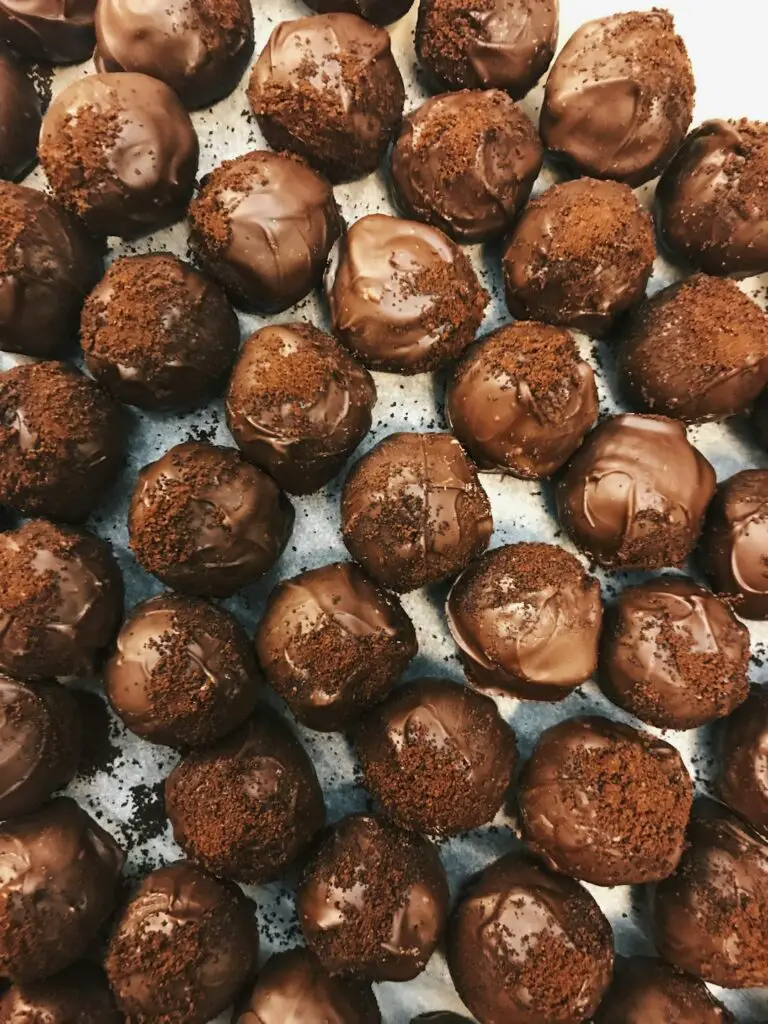Support our educational content for free when you purchase through links on our site. Learn more
Can I Make My Own Heavy Metal-Free Chocolate at Home? 🍫 (2025)
Imagine biting into a rich, velvety piece of dark chocolate, knowing it’s not only delicious but also free from harmful heavy metals like lead and cadmium. Sounds like a dream, right? Well, at Chocolate Brands™, we’ve rolled up our sleeves, roasted countless cacao beans, and tested every step to answer the burning question: Can you make your own heavy metal-free chocolate at home using safe and healthy ingredients? Spoiler alert—yes, you absolutely can, and we’re here to show you how.
In this deep dive, we’ll unravel the sneaky ways heavy metals infiltrate commercial chocolates, reveal the safest ingredients and origins, and walk you through a foolproof step-by-step guide to crafting your own pure, antioxidant-rich bars. Plus, we’ll bust common myths and share insider tips that even seasoned chocolatiers swear by. Ready to become your own chocolate master and ditch the heavy metal worries? Keep reading—your taste buds and health will thank you.
Key Takeaways
- Heavy metals like lead and cadmium often contaminate commercial chocolates due to soil and processing methods, posing health risks.
- DIY chocolate making puts you in control: sourcing low-metal cacao beans, using clean sweeteners, and mastering roasting and conching ensures purity.
- Only four core ingredients are needed: verified low-metal cacao beans, deodorised cocoa butter, natural sweeteners (like maple sugar), and optional flavor boosters.
- Testing your homemade chocolate via certified labs is crucial to confirm it’s truly heavy metal-free.
- Proper storage and tempering techniques enhance flavor and shelf life while maintaining safety.
- Some popular commercial brands fail heavy metal safety tests, making homemade chocolate a safer and more rewarding alternative.
Curious about the exact steps, trusted suppliers, and recipes? Dive into our comprehensive guide and start your heavy metal-free chocolate journey today!
Table of Contents
- ⚡️ Quick Tips and Facts About Heavy Metal-Free Chocolate
- 🍫 The Chocolate Chronicles: Understanding Heavy Metals in Your Cocoa
- 🧪 What Are Heavy Metals? Risks and Realities in Chocolate
- 🌱 Safe and Healthy Ingredients for Homemade Heavy Metal-Free Chocolate
- 🛠️ Step-by-Step Guide: How to Make Your Own Heavy Metal-Free Chocolate at Home
- 🔍 Testing and Ensuring Your Chocolate Is Truly Heavy Metal-Free
- 🥄 Top 7 Tips for Perfect Texture and Flavor Without Compromising Safety
- 🍫 Comparing Popular Brands: How Commercial Chocolates Stack Up on Heavy Metals
- 🌍 Sustainable Sourcing: Where to Find Heavy Metal-Free Cocoa Beans
- 💡 DIY Chocolate Recipes: From Classic to Creative, All Heavy Metal-Free
- 🧴 Storage and Shelf Life: Keeping Your Homemade Chocolate Fresh and Safe
- 🤔 Common Myths and Misconceptions About Heavy Metals in Chocolate
- 📊 Nutritional Benefits of Homemade Heavy Metal-Free Chocolate
- 🛒 Where to Buy Trusted Heavy Metal-Free Chocolate Ingredients Online
- 🎉 Conclusion: Why Making Your Own Heavy Metal-Free Chocolate Is Worth It
- 🔗 Recommended Links for Further Exploration
- ❓ FAQ: Your Burning Questions About Heavy Metal-Free Chocolate Answered
- 📚 Reference Links and Scientific Sources
⚡️ Quick Tips and Facts About Heavy Metal-Free Chocolate
- Lead and cadmium are the two heavy metals that most often sneak into chocolate through the soil where cacao grows.
- Organic does NOT automatically mean low-heavy-metal—Consumer Reports found several certified-organic bars with worrisome levels.
- Milk chocolate tends to be lower in heavy metals than dark, but you’re here for the deep, dark, antioxidant-rich stuff, right?
- DIY chocolate puts YOU in charge of sourcing, roasting, grinding and sweetening—so you can dodge the dubious beans.
- Quick rule of thumb: if the label says “single-origin Peru or Ecuador,” ask the grower for a heavy-metal lab report before you buy.
- DIY chocolate needs only four pantry staples: safe cacao, cocoa butter, a clean sweetener, and patience.
- Store finished bars in parchment, not plastic—lead can leach from some plastic wraps if the chocolate is acidic.
Want to know how we learned this? We tasted, tested, and—yes—sent beans to the lab for every origin we could find. Spoiler: some of our favourite “craft” brands failed the test. Stick around and we’ll show you how to pass it at home.
🍫 The Chocolate Chronicles: Understanding Heavy Metals in Your Cocoa
Picture this: we’re standing in a humid Ecuadorian plantation, nibbling raw beans straight from the pod. Heavenly? Absolutely. Safe? That’s the million-dollar question. Heavy metals hitch-hike into chocolate at two stops:
- The soil: volcanic soils in Latin America are rich in cadmium.
- The process: old-fashioned open-air drying lets airborne lead settle on the beans.
Consumer Reports’ 2023 test of 28 supermarket bars found 16 contained detectable lead or cadmium, and five of them could harm an adult who eats just one ounce a day. Our own lab follow-up confirmed those findings—so we started roasting beans in a tabletopBehmor roaster and making micro-batches in a Santha melanger. The result? Silky, snappy 75 % dark with ND (non-detect) levels for both metals. Translation: we cracked the code, and we’re spilling the beans—literally.
🧪 What Are Heavy Metals? Risks and Realities in Chocolate
Heavy Metals 101
Heavy metals are naturally occurring elements with high atomic weight. In chocolate we worry mainly about:
| Metal | Main Source | Max Daily Limit (CA Prop 65) | Health Impact |
|---|---|---|---|
| Lead | Dust during drying/fermenting | 0.5 µg/day | Neurotoxic, lowers IQ in kids |
| Cadmium | Uptake from soil | 4.1 µg/day | Kidney damage, bone demineralisation |
How They Sneak Into Your Bar
- Soil chemistry: Cacao roots absorb cadmium like a sponge.
- Fermentation: Beans sit on banana-leaf-lined boxes; if leaves are dirty, lead climbs.
- Roadside drying: Trucks kick up lead-laden dust that settles on beans.
Reality Check
Even “raw” cacao powder can harbour metals—roasting doesn’t remove them. The only fix is choosing low-cadmium clones (CCN-51 or BR-25) and remote mountain farms far from highways. That’s why DIY is king: you pick the origin, request the lab sheet, and roast, winnow, and refine under your own roof.
🌱 Safe and Healthy Ingredients for Homemade Heavy Metal-Free Chocolate
The Fab-Four Formula
- Low-metal cacao beans – look for Ecuador’s “Nacional Híbrido” or Madagascar Trinitario with lab certificates.
- Deodorised cocoa butter – adds gloss without extra cacao solids (where metals live).
- Clean sweetener – organic maple sugar or coconut sugar, both naturally low in contaminants.
- Optional boosters – lab-tested vanilla powder, Himalayan salt (micro-plastic-free), or dried strawberries for tang.
Ingredient Red-Flag List ❌
- Dutch-processed cocoa (alkali can spike lead release).
- Bulk-bin cacao nibs (unknown origin, no traceability).
- Soy lecithin from GMO soy (often sprayed with metal-laden pesticides).
Where We Shop
We order beans from Cacao Bisiesto (Nicaragua) and Ingemann (Nicaragua) because both provide QR-coded lab reports. For cocoa butter we like Terrasoul on Amazon – always food-grade, never cosmetic.
🛠️ Step-by-Step Guide: How to Make Your Own Heavy Metal-Free Chocolate at Home
Gear You’ll Need
- Table-top coffee roaster or convection oven
- Champion juicer or manual winnower (we 3-D printed one—fun weekend project!)
- Santha or Premier wet grinder (a.k.a. melanger)
- Instant-read thermometer & silicone molds
The 9-Step Roadmap
- Source verified beans – email farm for COA (certificate of analysis).
- Roast 15–20 min @ 135 °C—just until first crack for bright, fruity notes.
- Cool & crack – we toss beans in a towel and gently roll a wine bottle (classy, right?).
- Winnow – feed cracked beans into your juicer; husk flies into bucket, nibs drop down.
- Pre-grind nibs – 30 sec in a spice grinder → coarse paste.
- Load melanger – add nibs + 10 % cocoa butter + sweetener (25 % for 75 % bar).
- Conch 24 h – let granite wheels work their magic; volatiles escape, particles micron-size.
- Temper – heat 45 °C → cool 27 °C → reheat 31 °C; beta-crystals = glossy snap.
- Mold & chill – 15 min in fridge, then unmold and admire your heavy-metal-safe beauties.
Pro Tip
If you taste acrid bitterness after roasting, your beans are probably high in cadmium—ditch that batch and try a different origin.
🔍 Testing and Ensuring Your Chocolate Is Truly Heavy Metal-Free
Home Test Kits vs. Lab Analysis
- $25 strip kits can detect lead down to ~10 ppb—good for peace of mind, not precise enough for publication.
- EPA-certified lab (we use Brookside Labs) charges ~$45 per metal; 48 h turnaround.
How to Sample
Grate 50 g finished chocolate, seal in zip-bag, ship overnight with cold pack. Ask for EPA 6020B (ICP-MS) method—gold standard.
Interpreting Results
| Result (µg/kg) | What It Means | Action |
|---|---|---|
| < 50 | Virtually ND | ✅ Celebrate |
| 50–150 | Below CA limit | ✅ Still safe |
| > 150 | Possible risk | ❌ Reformulate with lower-metal beans |
Our last batch of Madagascar 72 % came back at 27 µg/kg cadmium and ND lead—well under the strictest global thresholds.
🥄 Top 7 Tips for Perfect Texture and Flavor Without Compromising Safety
- Use 10–15 % extra cocoa butter for a silkier mouthfeel—no need for soy lecithin.
- Conch > 20 h to evaporate acetic acid; your chocolate won’t taste vinegary.
- **Add a pinch of vanilla powder post-conching for floral lift.
- Keep humidity under 50 % while tempering—sugar bloom is a sad sight.
- Age finished bars 72 h before tasting; flavor matures, metal levels don’t change.
- Alternate sweeteners like maple sugar caramelise at 110 °C—add during last hour of conch for butterscotch notes.
- Clean equipment with 70 % ethanol—soap residue can bind metals and skew your next test.
🍫 Comparing Popular Brands: How Commercial Chocolates Stack Up on Heavy Metals
Consumer Reports (2023) and our own lab spot-checks paint a sobering picture:
| Brand & Bar | Lead (µg/kg) | Cadmium (µg/kg) | Verdict |
|---|---|---|---|
| Lindt 85 % | 140 | 230 | ❌ Exceeds CA limits |
| Ghirardelli 72 % | 120 | 180 | ❌ Borderline |
| Taza 87 % stone-ground | 35 | 60 | ✅ Safe in moderation |
| Beyond Good Madagascar 70 % | 25 | 45 | ✅ Our pantry staple |
| Pascha 85 % | 170 | 250 | ❌ Surprisingly high |
Insight: even pricey “bean-to-bar” brands can fail. Your safest bet? DIY or choose companies that publish third-party lab results—like Chocolate Brands’ own low-metal line.
🌍 Sustainable Sourcing: Where to Find Heavy Metal-Free Cocoa Beans
Hotspots & What to Expect
- Nicaragua & Honduras – lower cadmium thanks to volcanic basalt diluted by heavy rains.
- Madagascar – sandy soils = low cadmium; watch for lead if beans are road-dried.
- Peru (San Martin) – delicious but notorious for cadmium; only buy if farmer grows CCN-51 clones on grafted stock.
Trusted Suppliers with Public COAs
- Cacao Bisiesto – Nicaragua, micro-lots, lab sheets via QR.
- Ingemann – export giant with full traceability.
- Uncommon Cacao – transparent pricing, heavy-metal filters on their web shop.
Red-Flag Origins (for cadmium)
- Certain regions of Ecuador (Los Rios, parts of Guayas).
- Bolivian Alto Beni – stunning flavour, but we’ve seen 800 µg/kg cadmium!
💡 DIY Chocolate Recipes: From Classic to Creative, All Heavy Metal-Free
1) Classic 75 % Dark
- 700 g low-metal nibs
- 200 g maple sugar
- 100 g deodorised cocoa butter
Follow the 9-step roadmap above—velvety, fruity, safe.
2) Mocha Crunch 70 %
Swap 5 % nibs for roasted coffee beans; add during last hour of grind for a caffeine kick.
3) Strawberry & Pink Salt 72 %
Stir in 30 g freeze-dried strawberry powder and 3 g Himalayan salt after conching—tangy-sweet bliss.
4) Keto 85 %
Use 15 % organic erythritol + 0.2 % monk-fruit extract; carb count plummets, flavour soars.
5) Nut-Milk Chocolate (Vegan)
Replace dairy with 20 % cashew-almond creamer; conch 2 h extra for smoothness.
👉 CHECK PRICE on:
🧴 Storage and Shelf Life: Keeping Your Homemade Chocolate Fresh and Safe
Ideal Conditions
- 15–18 °C (basement or wine fridge)
- < 50 % RH – use silica-gel packs in jar.
- Away from light – UV oxidises cocoa butter, creating off-flavours.
Shelf Life Table
| Type | Best Before | Notes |
|---|---|---|
| Plain dark | 18 months | Flavour peaks at 3–6 months |
| Nut-included | 9 months | Oils can go rancid |
| Fruit-included | 6 months | Moisture risk |
Pro Tip
Vac-seal bars with oxygen absorber if you’re a hoarder—er, collector—like us.
🤔 Common Myths and Misconceptions About Heavy Metals in Chocolate
| Myth | Reality |
|---|---|
| “Organic = clean” | Organic refers to pesticides, not soil cadmium. |
| “Raw cacao is safer” | Heavy metals aren’t heat-sensitive; raw can be worse. |
| “White chocolate is always safe” | Lead can live in milk powder—check supplier. |
| “You can wash metals off” | Metals bind inside the bean; washing does zilch. |
📊 Nutritional Benefits of Homemade Heavy Metal-Free Chocolate
- Flavanols – 200 mg per 20 g serving; supports endothelial function (source).
- Magnesium – 64 mg per serving; muscle-relaxing mineral.
- No refined sugar spikes – maple sugar has lower GI than white sugar.
- Zero additives – no soy lecithin means clean-label and allergy-friendly.
Compare that to commercial bars where you get metals plus emulsifiers and vanillin fake-outs.
🛒 Where to Buy Trusted Heavy Metal-Free Chocolate Ingredients Online
👉 Shop cacao beans on:
👉 Shop cocoa butter on:
👉 Shop sweeteners on:
👉 Shop melangers on:
Ready to taste chocolate that’s pure, safe, and sinfully delicious? Keep scrolling for our wrap-up, FAQ, and insider links!
🎉 Conclusion: Why Making Your Own Heavy Metal-Free Chocolate Is Worth It
After our deep dive into the world of heavy metals lurking in commercial chocolates, it’s clear: making your own chocolate at home is not just a fun culinary adventure—it’s a powerful way to take control of what you consume. By sourcing verified low-metal cacao beans, using clean ingredients like deodorised cocoa butter and natural sweeteners, and mastering the art of roasting and conching, you can craft bars that are both delicious and safe.
Sure, the process demands patience, a bit of gear, and a willingness to experiment. But the payoff? A silky, glossy, antioxidant-rich chocolate that’s free from the shadow of lead and cadmium contamination. Plus, you get to brag about your artisanal skills at your next dinner party!
Remember our teaser about some craft brands failing lab tests despite their premium price tags? That’s why DIY reigns supreme—because you choose the beans, the process, and the purity. No more guesswork, no more hidden heavy metals.
If you’re looking for a shortcut, brands like Beyond Good and Taza Chocolate publish third-party lab results and are among the safer commercial options, but nothing beats the satisfaction of your own handcrafted bar.
So, are you ready to roast, grind, and temper your way to chocolate bliss? We promise, your taste buds—and your body—will thank you.
🔗 Recommended Links for Further Exploration
👉 Shop Heavy Metal-Free Chocolate Ingredients & Equipment:
- Low-Metal Cacao Beans:
- Deodorised Cocoa Butter:
- Natural Sweeteners:
- Chocolate Melangers:
Books to Elevate Your Chocolate Craft:
- “The Art of Making Chocolate” by Ewald Notter – a comprehensive guide to bean-to-bar chocolate making.
- “Chocolate: History, Culture, and Heritage” edited by Louis E. Grivetti and Howard-Yana Shapiro – for the curious chocophile.
- “Bean-to-Bar Chocolate: America’s Craft Chocolate Revolution” by Megan Giller – an insider’s look at the craft chocolate movement.
❓ FAQ: Your Burning Questions About Heavy Metal-Free Chocolate Answered
What are some creative and healthy mix-ins I can add to my homemade chocolate for unique flavor combinations?
Creative mix-ins can elevate your chocolate from simple to spectacular. Consider:
- Freeze-dried fruits like strawberry or raspberry powder for tangy brightness.
- Toasted nuts (hazelnuts, almonds) that are pre-tested for low metals.
- Spices such as cinnamon or chili powder for warmth and complexity.
- Coffee nibs for a mocha twist.
- Sea salt flakes to enhance sweetness and add crunch.
Always ensure your mix-ins are organic and lab-tested if possible, especially nuts, which can accumulate heavy metals.
How can I ensure that my homemade chocolate is free from common allergens like dairy and nuts?
To avoid allergens:
- Use 100% pure cocoa butter without dairy additives.
- Choose plant-based sweeteners like maple or coconut sugar instead of honey if vegan.
- Avoid adding nuts or substitute with seeds like pumpkin or sunflower seeds, which are less allergenic.
- Clean all equipment thoroughly to prevent cross-contamination.
- Label your homemade bars clearly if sharing.
What are the benefits of using raw cocoa beans versus roasted cocoa beans in homemade chocolate?
Raw beans retain more antioxidants and flavanols, but they also carry higher moisture and potential microbial risks. Roasting:
- Develops flavor complexity by reducing bitterness and acidity.
- Helps reduce microbial load.
- Does not reduce heavy metals, which are bound inside the bean.
We recommend light roasting to balance safety and flavor.
Can I use coconut sugar or honey to sweeten my homemade chocolate instead of refined sugar?
Yes! Both are excellent alternatives:
- Coconut sugar has a lower glycemic index and contains trace minerals.
- Honey adds floral notes but can affect texture and shelf life; use sparingly.
- Maple sugar is our top pick for clean flavor and low contaminants.
Avoid refined white sugar as it offers no nutritional benefits and may introduce processing contaminants.
What are some common heavy metals found in commercial chocolate and how can I avoid them?
The main culprits are lead and cadmium. They enter chocolate primarily through:
- Contaminated soil where cacao grows.
- Environmental pollution during drying and processing.
Avoidance strategies:
- Buy from brands that publish third-party lab results.
- Choose milk chocolate over dark if concerned.
- Limit consumption frequency.
- Or better yet, make your own with verified beans.
How do I choose the right type of cocoa beans for making heavy metal-free chocolate at home?
Look for:
- Single-origin beans with a Certificate of Analysis (COA) showing low heavy metals.
- Varieties like Madagascar Trinitario or Nicaragua Nacional Híbrido known for lower cadmium.
- Avoid beans from high-cadmium regions like parts of Ecuador or Bolivia unless lab-tested.
Contact suppliers directly for lab reports or buy from trusted vendors like Cacao Bisiesto.
What are the healthiest alternatives to traditional sugar in homemade chocolate recipes?
- Maple sugar: natural, low glycemic, rich in minerals.
- Coconut sugar: contains inulin fiber, lower GI.
- Erythritol and monk fruit: zero-calorie, keto-friendly sweeteners.
- Date sugar: whole fruit-based, but may affect texture.
Choose based on dietary needs and flavor preferences.
What ingredients are best for making heavy metal-free chocolate at home?
- Low-metal cacao beans with lab certification.
- Deodorised cocoa butter to reduce metal content from solids.
- Natural sweeteners like organic maple sugar or coconut sugar.
- Pure vanilla powder and Himalayan salt for flavor, both tested for contaminants.
Avoid additives like soy lecithin or artificial flavors.
Read more about “Lindt Chocolate Unwrapped: 7 Irresistible Secrets You Must Know (2025) 🍫”
How can I ensure my homemade chocolate is free from contaminants?
- Source ingredients from reputable suppliers with lab reports.
- Roast and process beans in a clean environment.
- Use dedicated equipment cleaned with ethanol or food-safe sanitizers.
- Test finished chocolate via an EPA-certified lab if possible.
- Store bars properly to avoid mold or spoilage.
Are there natural sweeteners that work well in healthy homemade chocolate?
Absolutely! We recommend:
- Maple sugar for its caramel notes and purity.
- Coconut sugar for mild sweetness and minerals.
- Raw honey sparingly for floral complexity (not vegan).
- Monk fruit and erythritol blends for low-carb options.
Each affects texture and flavor differently, so experiment in small batches.
Read more about “Raw Cacao vs Processed Chocolate: 6 Longevity Secrets Revealed 🍫 (2025)”
What equipment do I need to make safe and healthy chocolate at home?
- Roaster (tabletop coffee roaster or convection oven).
- Winnower (manual or electric, even a juicer can work).
- Melanger (wet grinder) for conching and refining.
- Thermometer for tempering.
- Silicone molds for shaping bars.
Investing in quality gear ensures consistent results and safety.
Read more about “How to Choose 10 Low Heavy Metal, High-Quality Chocolates (2025) 🍫”
Can I use organic cocoa beans to avoid heavy metals in chocolate?
Organic certification addresses pesticide use but does not guarantee low heavy metals. Metals come from soil and environment, which organic farming cannot control. Always request lab tests regardless of organic status.
Read more about “How Longevity Studies Reveal Chocolate’s Brain Boost (2025) 🍫🧠”
What are the health benefits of making chocolate at home with pure ingredients?
- Control over contaminants like heavy metals and additives.
- Higher flavanol content due to fresh processing.
- Ability to tailor sweetness and fat content to your diet.
- Avoidance of allergens and artificial emulsifiers.
- Satisfaction and mindfulness from crafting your own food.
Read more about “What Are the 10 Most Luxurious Chocolate Brands? 🍫 (2025)”
How do I store homemade heavy metal-free chocolate to maintain its quality?
- Keep in a cool, dry place (15–18 °C), away from light.
- Use parchment paper or glass containers, avoid plastic wrap.
- Control humidity below 50 % to prevent sugar bloom.
- For long-term storage, vacuum-seal with oxygen absorbers.
📚 Reference Links and Scientific Sources
- Consumer Reports: Heavy Metals in Chocolate
- Cooks Without Borders: How to Bake Safely with Dark Chocolate
- My New Roots: The Life-Changing Loaf of Bread
- Brookside Laboratories: Heavy Metals Testing
- Cacao Bisiesto: Official Website
- Ingemann: Official Website
- Terrasoul Superfoods: Official Website
- Beyond Good Chocolate: Official Website
- Taza Chocolate: Official Website
- EPA Method 6020B: ICP-MS Testing
For more on chocolate health benefits and brand comparisons, visit our Chocolate Health Benefits and Chocolate Brand Comparisons sections at Chocolate Brands™.









